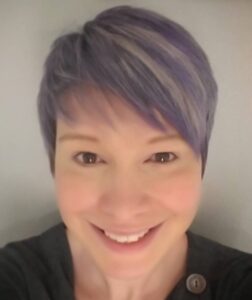Sign Language Week 2023
Sign Language Week 2023
For Sign Language Week, we wanted to learn more about Deaf Culture and help to raise awareness as this is key to encouraging everyone to realise how important British Sign Language is and the positive impact that it has on thousands of Deaf and hard of hearing people.
We caught up with Vicky, Team Leader at York Housing Wellbeing Service. Vicky is Deaf and a BSL user.

Please can you tell us about your role and a short summary of your career at Community Links?
I started off nearly 5 years ago as a Housing Support Worker and then became the Team Lead, both in York. I lead a team of amazing Housing Support Workers in York and we support people with mental health needs to manage their housing needs. The work we do is varied and no two days are the same!
It is Sign Language Week and the theme this year is ‘Protecting BSL.’ What does this mean to you?
BSL is my native language – I am a 3rd Generation Deaf person, with Deaf sibling, parents, grandparents, auntie and uncle, husband, and child. BSL is the language of the Deaf Community to which I belong. You may notice I use capital D in the word Deaf – this is to show that I am culturally Deaf, as opposed to just medically deaf.
BSL is not just flapping your hands about in a series of separate signs – its immersive and involves body movement, fluidity, gestures, facial expressions, and idioms unique to BSL.
This year’s theme of Protecting BSL is so important as BSL was finally recognised as an official language last April after decades of campaigning. Since then, there has been more awareness. Unfortunately, there are people and organisations who have no experience or understanding of the language and the Deaf Culture but are promoting their own version of BSL which is often badly done or in some cases, completely made up and is not BSL at all. People watch these videos online believing that it is BSL and repeating them which causes a lot of distress to Deaf people who are seeing our language being eroded by these made-up signs.
So, it is very important to protect the language and ensure that it is shared and taught by Deaf people with lived experience of using BSL every day. That way, everyone will get the authentic language and everything else that comes with it.
Why is it important to learn more about Deaf culture?
First thing to learn is that the Deaf culture is not the same as the Hearing Culture! We have our own norms, expected behaviours etc. For example, it’s perfectly fine to tap complete strangers on the shoulder or back to get their attention. In fact it is seen as rude just to stand patiently behind a D/deaf person waiting for them to turn around. I have lost count of how many times that has happened to me, turning around unaware that there is someone standing behind me and getting a fright!
One thing about BSL and the culture is that Deaf people can sometimes come across as blunt to a Hearing person. This is because BSL is a visual language, there is no hiding behind idioms or polite phrases to soften the blow of a truth that may be harsh. We say what we think, unvarnished and unfiltered. That’s something I really struggle with in the hearing world with constantly being told to practice being a little bit more diplomatic in how I phrase things!
Lastly, we have successful actors, musicians and dancers and comedians all of whom incorporate BSL and Deaf culture into their art. We have a channel online called BSL Zone and the link here is an example of a brilliant comedy show (subtitles are available!)
We have our own art form called Visual Vernancular (VV) – it’s a combination of gestures and dance – you don’t actually need to be able to understand BSL to understand VV. See here for an example.
We have a Deaf “newspaper” – https://limpingchicken.com/. There’s a story about how the publication got the name – it involves a chicken with a limp!
“Deaf Time” is another thing – probably my favourite part of the culture. Saying goodbye is a very lengthy process for us Deafies! Literally hours to say goodbye. This comes from the fact that historically and for many, still now, Deaf people live in isolation away from each other and so when we do meet up, we make the most of that time and drag it out as much as we can. We will start off saying “Bye I gotta go” only to get drawn into another conversation and we do this with every single person there!
To learn more about Sign Language Week- click here.
